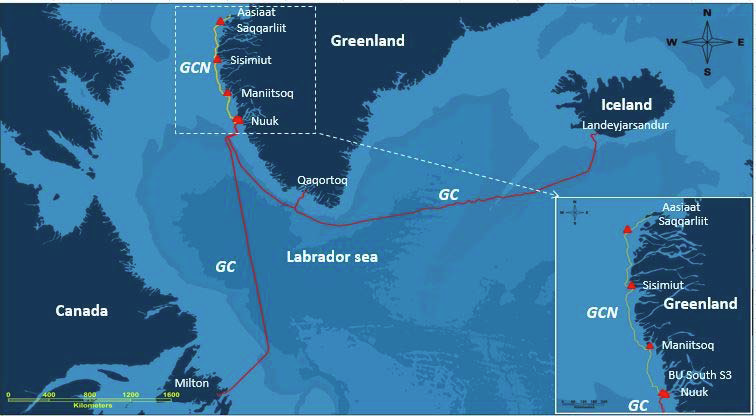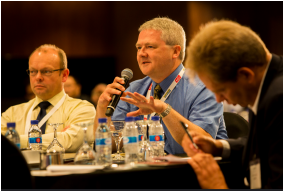|
Huawei Marine today announced that it will partner with Tele Greenland for the deployment of a 100 Gbit/s network along the Greenlandic West Coast as well as a capacity upgrade of the existing Greenland Connect which connects Greenland with Iceland/Europe and North America. When completed, the new system will create a record - the world’s most northern 100 Gbit/s submarine network. Facing Iceland and Canada, Greenland is located between the Arctic and Atlantic Oceans with 80% of the island covered by ice and snow year round. Huawei Marine will supply and, in collaboration with Tele Greenland, install Submarine Line Terminal Equipment for the domestic submarine cable system, Greenland Connect North, which will connect Nuuk, Maniitsoq, Sisimiut, and Aasiaat. The new system will initially hold a capacity of 100 Gbit/s to each town. In addition Huawei Marine will supply and install Submarine Line Terminal Equipment for the existing Greenland Connect system, which connects Greenland, Iceland and Canada. The initial capacity will be 100 Gbit/s. Figure 12 - Greenland Connect Cable Map Source: Huawei Marine
The supply for the new Greenland Connect North system will have a design capacity of 4.8 Tbit/s, while the design capacity for Greenland Connect will be increased from 1.92 Tbit/s to 12.8 Tbit/s between Greenland, Europe and North America. By deploying new generation OTN-based unified terrestrial and submarine transmission equipment, Huawei Marine will provide advanced 100 Gbit/s solutions for Tele Greenland to achieve flexible unified management of both the Greenland Connect North and Greenland Connect systems. The supply allows both systems to achieve a multi-granularity OTN cross-connection and flexible bandwidth allocation to minimize operating costs and maximise the return on investment. Chief Wholesale Officer Flemming Drechsel from Tele Greenland said: “The Greenland Connect system is Greenland’s vital communication line, and there is little margin for error in the implementation and operation of the new system. Over the course of the negotiation process with several well-esteemed system providers, the Huawei Marine team has won Tele Greenland’s full confidence, that Huawei Marine will provide the highly reliable 100 Gbit/s DWDM equipment needed to enable us to deliver and fulfill our commitments to our customers.” Mao Shengjiang, Chief Operating Officer of Huawei Marine said: “It is a great honor to cooperate with Tele Greenland and to further gain recognition of Huawei Marine’s technology and delivery capability. It is not the first time for Huawei Marine to deploy a 100 Gbit/s network in the Arctic region, therefore I believe that our experienced team will meet the challenges and successfully deliver our products services to help our customers and expand their networks to these remote regions.”. Source: Huawei Marine Press Release ANALYSIS: It is no surprise that, having built the original Greenland Connect cable which brought connectivity to Nuuk and Qaqortoq, Greenland, Tele Greenland would come under pressure to extend the service to other parts of the country. The original cable was commissioned in March 2009 by Alcatel Submarine Networks (now known as Nokia) using 10 Gbit/s DWDM technology. It has therefore taken seven years for the impact of the submarine cable to be appreciated and then for the government of Greenland to find the funding for this extension. Perhaps more surprising is that Tele Greenland did not opt to go back to the original supplier for this extension and upgrade. Huawei Marine (HMN) has recently installed the Sakhalin-Magadan-Kamchatka cable for Rostelecom in the Sea of Okhotsk on a similar latitude to Greenland. This recent experience and successful implementation may have been a deciding factor in Tele Greenland's choice of system supplier. HMN is claiming a massive yield from the upgrade to the existing Greenland Connect system. Based on upgrades using initial versions of 100 Gbit/s technology, one would have expected this 10 Gbit/s with an original design capacity of 1.92 Tbit/s to be upgradeable to a new design capacity of around 8 Tbit/s i.e. 4 times. However, HMN appears to have achieved a multiple closer to 7 times, indicating that coherent technology is continuing to develop. Nevertheless, the number of 10 Gbit/s or 40 Gbit/s systems that remain significant in the markets they serve and are therefore worth upgrading to 100 Gbit/s is dwindling. Announcements such as this are becoming fewer and further between.
0 Comments
Leave a Reply. |
Julian Rawle, AuthorThought leadership articles and commentary on developments related to the subsea fibre optic cable industry can be found here. Archives
February 2018
Categories |




 RSS Feed
RSS Feed